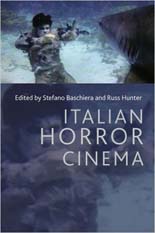
 While regular visitors to this site would join me in disagreement, the very things that make horror films from Italy so distinctive — namely, unflinching violence, oft-excessive gore and heavily linked sexuality — are why scholars and critics long have turned their collective noses up at it. And yet, even a casual viewing of Mario Bava or Dario Argento works reveals real visual artistry at work, even amid controversy.
While regular visitors to this site would join me in disagreement, the very things that make horror films from Italy so distinctive — namely, unflinching violence, oft-excessive gore and heavily linked sexuality — are why scholars and critics long have turned their collective noses up at it. And yet, even a casual viewing of Mario Bava or Dario Argento works reveals real visual artistry at work, even amid controversy.
Standing on our side are Stefano Baschiera and Russ Hunter, co-editors of Italian Horror Cinema, and their 11 fellow contributors, giving the form that study of which others find it unworthy. The best kind of academic-minded texts (read: accessible), the trade paperback is ready-made reading for the genre’s most fervent enthusiasts, whose hunger doesn’t end with the final shot.
New from Edinburgh University Press, Italian Horror Cinema pushes Lucio Fulci on the shark-vs.-zombie cover and, within a baker’s dozen of essays that awaits inside, seemingly every remaining Italian filmmaker of note, right up to such current directors as Hélène Cattet and Bruno Forzani, the team behind The Strange Color of Your Body’s Tears.
Russ Hunter lays the trade paperback’s foundation with an informative survey of the country’s early fright fare, including a silent Frankenstein picture and — exclamation theirs — 1916’s I Prefer Hell! This provides proper context for the articles that immediately follow, chronicling Italian horror’s international dawn in the 1960s to its largely retro-reflexive existence today, with an in-between stop to the living rooms of a VHS-obsessed ’80s. While chapters on Bava and Argento are expected, their theses are not; in the latter case, that means Karl Schoonover’s study on how the maestro treats the ecological and the unwanted.
The further the reader goes, the more specific the contents become. Adam Lowenstein demonstrates the influence of the giallo on the all-American slasher film, with a primary focus on the now-iconic Friday the 13th; turns out, the relationship is akin to the peanut butter and chocolate of a Reese’s cup. Meanwhile, a less healthy marriage — that of (often unsimulated) animal cruelty in the cannibal epics — is probed by Mark Bernard (whose terrific Selling the Splat Pack was published by Edinburgh last year). Those moviegoers who extend their love of cinema into their choices of reading material and listening pleasure will appreciate the chapters on Italian film journals and the unsettling yet irresistible soundtracks of Goblin. —Rod Lott
